DAILY CURRENT AFFAIRS (DECEMBER 28, 2021)
THE INDIAN POLITY AND GOVERNANCE
1. FOURTH EDITION OF STATE HEALTH INDEX: 2019-20
THE CONTEXT: NITI Aayog released the fourth edition of the State Health Index for 2019–20. The report, titled “Healthy States, Progressive India”, ranks states and Union Territories on their year-on-year incremental performance in health outcomes as well as their overall status.
THE EXPLANATION:
- The report has been developed by NITI Aayog, with technical assistance from the World Bank, and in close consultation with the Ministry of Health and Family Welfare (MoHFW).
- Round IV of the report focuses on measuring and highlighting the overall performance and incremental improvement of states and UTs over the period 2018–19 to 2019–20.
What are the indicators?
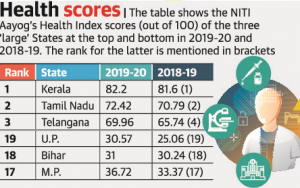
- Health Index is a weighted composite score incorporating 24 indicators covering key aspects of health performance. Health Index comprises of select indicators in three domains:
- Health Outcomes.
- Governance and Information; and
- Key Inputs and Processes.
- Each domain has been assigned weights based on its importance with higher score for outcome indicators.
- To ensure comparison among similar entities, the ranking is categorized as ‘Larger States’, ‘Smaller States’ and ‘Union Territories’.
- Among the ‘Larger States’, in terms of annual incremental performance, Uttar Pradesh, Assam and Telangana are the top three ranking states.
The Findings:
Among large states, Kerala and Tamil Nadu topped the list, and Telangana emerged strong on the third position in health outcomes and incremental performance. The state saw an improvement from the 4th position the last time — indicating that it has made strides in improving its health infrastructure by ensuring universal immunisation of children, setting up fully functional First Referral Units (FRUs) and all Primary Health Centres (PHCs) among others.
Among the ‘Larger States’, in terms of annual incremental performance, Uttar Pradesh, Assam and Telangana are the top three ranking states.
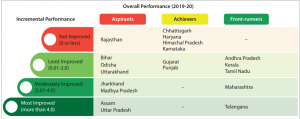
Among ‘Smaller States’, Mizoram and Meghalaya registered the maximum annual incremental progress.

Among UTs, Delhi, followed by Jammu and Kashmir, showed the best incremental performance.
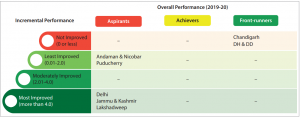
Key Points:
- For a vast majority of the states and UTs, there has been a shift in the Overall Performance ranking from Base Year (2018-19) to Reference Year (2019-20)
- The gap in the Overall Performance between the best and the worst performing Larger State and UTs narrowed in the current round of the Health Index, while it increased for the Smaller States.
- Nearly half the states and UTs did not reach the halfway mark in the Composite Overall Index Score, and despite good performance, even the top-ranking states and UTs could benefit from further improvements.
- The incremental changes in Health Index Scores from Base Year (2018-19) to Reference Year (2019-20) varied significantly across states and UTs, with a vast majority of Larger States registering at least some improvement.
The Conclusion:
- The Health Index is a useful tool to measure and compare the Overall Performance and Incremental Performance across states and UTs over time and nudging the states and UTs to shift the focus from inputs and outputs to outcomes.
- The Health Index has strengthened the culture of use of data at the state/UT level to monitor performance and is contributing to the agenda of improving availability, quality and timeliness of data.
2. RIGHT TO BE FORGOTTEN
THE CONTEXT: In December 2021, the Centre told the Delhi High Court that the “right to be forgotten” is part of the fundamental right to privacy, but added it has no significant role to play in the matter. Petitions across courts have been seeking enforcement of this “right” — a legal principle that is not yet backed by statute in India.
THE EXPLANATION:

What is the right to be forgotten?
- It allows a person to seek deletion of private information from the Internet. The concept has found recognition in some jurisdictions abroad, particularly the European Union. While the right is not recognised by law in India, courts in recent months have held it to be an intrinsic part of the right to privacy.
- At least eight petitions are pending before Delhi High Court seeking removal of private information from the Internet, court records of previous convictions and proceedings, and news reports of past events. Only a few have been able to get that relief from courts so far.
Which countries have such laws?
- The EU in 2018 adopted the General Data Protection Regulation (GDPR), Article 17 of which provides for the right to erasure of certain categories of personal data — that which is considered no longer necessary, that for which consent has been withdrawn or processing of which has been objected to, personal data unlawfully processed, and data where there is a legal obligation for erasure.
- However, the regulations limit the right to erasure in certain circumstances, including for reasons of public interest in the area of public health, for archiving purposes “in the public interest, scientific or historical research purposes or statistical purposes in accordance” and for “establishment, exercise or defence of legal claims.”
What is the position in India?
In a brief reply in one of the petitions earlier this week, the Centre told the Delhi High Court that the right to privacy has been recognised as a fundamental right in the K S Puttaswamy judgment (2017) and that the ‘right to be forgotten’ is evolving in India. The government said the Personal Data Protection Bill (a Joint Parliamentary Committee’s report on which was tabled on December 2021), contains provisions to the doctrine of the ‘right to be forgotten’.
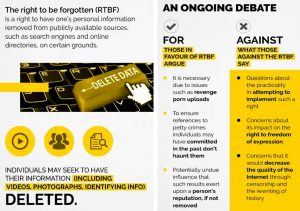
When can the right be exercised?
In the right to privacy judgment, the Supreme Court had clarified that the recognition of this right “does not mean that all aspects of earlier existence are to be obliterated, as some may have a social ramification”.
The SC explained: “If we were to recognise a similar right, it would only mean that an individual who is no longer desirous of his personal data to be processed or stored, should be able to remove it from the system where the personal data/information is no longer necessary, relevant, or is incorrect and serves no legitimate interest.”
The apex court asserted that this right cannot be exercised where the information or data is necessary for:
- exercising the right of freedom of expression and information.
- compliance with legal obligations.
- the performance of a task carried out in public interest, or public health.
- archiving purposes in the. public interest.
- scientific or historical research purposes or statistical purposes; or
- the establishment, exercise, or defence of legal claims.
CONCLUSION: Although the RTBF is a facet of the right to privacy, it has become very important in the digital age. The times when information is available at a click, the need to protect personal data becomes all the more important. Personal data such as related to matrimonial suits are of no relevance to the public. However, due to lack of proper legislation recognising this right people are subjected to harassment and loss of reputation. Therefore, legislation protecting this right is the need of the hour. Until then, the task is left to the judiciary which has to carefully tread its path between two fundamental rights- RTBF and freedom of expression.
THE INDIAN ECONOMY
3. TUSSLE OVER FCRA AND MISSIONARIES OF CHARITY (MoC)
THE CONTEXT: According to Union Home Ministry (MHA), the FCRA (Foreign Contribution Regulation Act) licence of Missionaries of Charity founded by Mother Teresa wasn’t renewed as some adverse inputs were received against it.
THE EXPLANATION:
- According to the 2020-21 annual financial returns filed by the MoC on December 13, 2021 it had received over ₹75 crore donation from 347 foreign individuals and 59 institutional donors. It had a balance of ₹27.3 crore in its FCRA account carried forward from the previous year and the total balance stood at ₹103.76 crore.
- The NGO registered in Kolkata has more than 250 bank accounts across the country to utilise the foreign funds. Some of the biggest donors are Missionaries of Charity in the U.S. and United Kingdom that contributed over ₹15 crore to MoC, India, for “primary health care, education assistance, treatment of leprosy patients” among others.
- The MoC in its statement clarified that “FCRA registration of Missionaries of Charity has neither been suspended nor cancelled. Further there is no freeze ordered by the Ministry of Home Affairs on any of our bank accounts”.
- The Foreign Contribution Regulation Act (FCRA) registration is mandatory for any NGO or association to receive foreign funds or donations.
- Mother Teresa had set up Missionaries of Charity, a Catholic religious congregation in 1950. She was awarded the Nobel Prize for Peace in 1979. She died on September 5, 1997, and was declared a saint by Pope Francis in September 2016.
- Registered associations can receive foreign contribution for social, educational, religious, economic and cultural purposes. Filing of annual returns, on the lines of Income Tax, is compulsory.
Value Addition:
Foreign Contribution (Regulation) Act:
- It is an act of Parliament enacted in 1976 and amended in 2010. It was to regulate foreign donations and to ensure that such contributions do not adversely affect internal security.
- Coverage: It is applicable to all associations, groups, and NGOs which intend to receive foreign donations.
- Registration: It is mandatory for all such NGOs to register themselves under the FCRA. The registration is initially valid for five years. Further, it can be renewed subsequently if they comply with all norms.
- Registered NGOs can receive foreign contributions for five purposes — social, educational, religious, economic, and cultural. There are 22,591 FCRA registered NGOs.
Foreign Contribution Regulation (Amendment) Rules 2020:
- New rules require any organization that wants to register itself under the FCRA to have existed for at least three years. Further, it should have spent a minimum of Rs. 15 lakh on its core activities during the last three financial years for the benefit of society.
- Office bearers of the NGOs seeking registration under the Foreign Contribution (Regulation) Act must submit a specific commitment letter from the donor. It should indicate the amount of foreign contribution and the purpose for which it is proposed to be given.
- Any NGO or person making an application for obtaining prior permission to receive foreign funds shall have an FCRA Account.
THE ENVIRONMENT AND ECOLOGY
4. AIR POLLUTION IN CENTRAL-WESTERN INDIA AND NORTH INDIA IN CONTRAST TO THE GENERAL TREND
THE CONTEXT: According to the study published in ‘Environmental Science and Pollution Research, by the Aryabhatta Research Institute of Observational Sciences (ARIES) showed that reduction of economic activities during the pandemic-related lockdown had resulted in decrease of air pollution in most parts of India, but satellite observations show that parts of central-western India and north India showed an increase in pollution in contrast to the general trend.
THE EXPLANATION:
- The satellite-based observation of toxic trace gases, — ozone, NO2, and carbon monoxide near the surface and in the free troposphere mostly showed reduction of the pollutants over India. However, over some regions like western – central India, some parts of Northern India, and Remote Himalaya, an increase of ozone and other toxic gases was observed. This could have aggravated respiratory health risks around those regions during the pandemic.
- Scientists have identified that regions in the central-western part of India and north India are prone to higher air pollution exposure based on state-of-the-art satellite observations and hence are exposed to greater risk of respiratory problems.
- Multi-satellite remote sensing of air pollutants has evolved dramatically over the last decade. Synergic measurements of satellite and in-situ observation provide a more comprehensive understanding of air pollution episodes. In 2020, a complete nationwide lockdown was imposed over India to impede the spread of coronavirus disease. This enormously disrupted the economy with a single positive side effect, a short-term improvement in the air quality near the surface.

- According to the results, carbon monoxide showed a consistent increase (as high as 31%) of concentration at higher heights during the lockdown. The long-range transport and downward transport from the stratosphere significantly increased ozone concentrations over north India during the lockdown, and remote regions like the Himalayas and coastal cities showed the bare minimum influence of lockdown in air quality, with a tendency to increase in criteria air pollutants.
- The ARIES team explains ozone production and loss are constrained through the complex photochemistry involving its precursor gases like nitrogen oxides (NOx) and volatile organic compounds (VOCs). A decrease in its precursor gases could also lead to enhancement of ozone, depending upon the chemical environment. Moreover, ozone concentrations are also altered via ambient meteorology and dynamics, including the downward transport of ozone-rich air from the stratosphere to the troposphere.
- According to the ARIES team, this study helped to identify the regions prone to higher air pollution exposure hence can identify areas at a greater health risk. The team previously, with scientists from the ISRO, showed INSAT-3D as a valuable Indian geostationary satellite to study ozone pollutions over India; however, for other criteria air pollutants (i.e., NO2, SO2, CO, VOCs, etc.), India is lacking in space-based observations and need air quality monitoring indigenous satellite in orbit.
Value Addition:
The six common air pollutants are:
- Particulate matter
- Ground-level ozone (Ground-level ozone is formed when volatile organic compounds (VOCs), also known as hydrocarbons, and nitrogen oxides (NOx) interact in the presence of sunlight.)
- Carbon monoxide
- Sulphur oxides
- Nitrogen oxides
5. IRANIAN KIWIS THREATEN KASHMIRI APPLES
THE CONTEXT: In early December 2021, the import of Iranian kiwis from Afghanistan to India has posed a major concern for apple dealers in Kashmir following a contagious quarantine pest threat found.
THE EXPLANATION:
- Since October 2021, India has intercepted quarantine pest ‘Aspidiotus netil’ in 22 consignments and ‘Pseudococcu Calceolariae’ pest in two Kiwi fruit consignments.
- According to the Union Ministry of Agriculture, India has suspended the import of fresh Kiwi fruits from Iran due to the rise in pest infested consignments from the middle eastern nation despite repeated warnings.

- The Import of Iran’s fresh Kiwi fruits has been banned with effect from December 2021 by the nodal body National Plant Protection Organization (NPPO) under the Agriculture Ministry.
- Earlier in 2019 too, India had intercepted a quarantine pest called ‘Aspidiotus netil’ from 13 consignments and a non-quarantine pest ‘Aonidiella aurantii’ from two consignments of Kiwi fruits from Iran. The non-compliance report has been sent on a regular basis to Iran for these consignments but so far no action has been taken nor the interception has decreased.”
- Also, the Ministry said the introduction of any quarantine pests through infested import consignments is a threat to Indian biosecurity and is dealt with under the provisions of Indian regulation.
- The Indian government has suspended the import of fresh kiwi fruits from India as each country has sovereignty and authority to protect itself. Iran government has also been requested to investigate the cases of non-compliance and submit an action taken report at the earliest with respect to remedial measures taken to avoid future interceptions.
- “Pests entering in the territory of any apple producing State shall be a catastrophe for local farmers”. Farmers have demanded a complete ban on import of apples from Iran “till the quarantine pest issue is resolved”.
- Currently, India imports 4,000 tonnes of Kiwis from various countries, while the domestic production is about 13,000 tonnes, as per the government data.
About Kashmir Apples:
- According to government figures, Kashmir exports around 20 lakh metric tons of apple every year, and the horticulture industry is pegged to be worth around 8000 to 9000 crores including the employment it generates. Kashmir produces 75% of the total apple production in the country.
National Plant Protection Organization (NPPO)
- The establishment or update of a National Plant Protection Organization (NPPO) by each contracting party is a major step towards international cooperation to prevent the introduction and spread of plant pests. This IPPC guide aims to support the establishment of a functional NPPO as the competent and legally responsible body for regulatory plant protection functions, as outlined in the IPPC.
THE SCIENCE AND TECHNOLOGY
6. 5G TECHNOLOGY
THE CONTEXT: According to the Department of Telecommunications (DoT) Delhi, Gurgaon, Mumbai, Bengaluru, Kolkata, Ahmedabad, Hyderabad, and Pune will be the first places to get 5G services next year i.e 2022.
THE EXPLANATION:
What is 5G technology and how is it different?
- 5G or fifth generation is the latest upgrade in the long-term evolution (LTE) mobile broadband networks. 5G mainly works in 3 bands, namely low, mid and high frequency spectrum — all of which have their own uses as well as limitations.
- While the low band spectrum has shown great promise in terms of coverage and speed of Internet and data exchange, the maximum speed is limited to 100 Mbps (Megabits per second).
- This means that while telcos can use and install it for commercial cell phone users who may not have specific demands for very high speed Internet, the low band spectrum may not be optimal for specialised needs of the industry.
- The mid-band spectrum, on the other hand, offers higher speeds compared to the low band, but has limitations in terms of coverage area and penetration of signals.
- The high-band spectrum offers the highest speed of all the three bands but has extremely limited coverage and signal penetration strength. Internet speeds in the high-band spectrum of 5G has been tested to be as high as 20 Gbps (giga bits per second), while, in most cases, the maximum internet data speed in 4G has been recorded at 1 Gbps.
Where does India stand in the 5G technology race?
- Like other global players, India had, in 2018, planned to start 5G services as soon as possible, with an aim to capitalise on the better network speeds and strength that the technology promised.
- All the three private telecom players, Reliance Jio Infocomm, Bharti Airtel and Vi, have been urging the DoT to lay out a clear road map of spectrum allocation and 5G frequency bands, so that they are able to plan the rollout of their services accordingly. One big hurdle, however, is the lack of flow of cash and adequate capital with at least two of the three players, namely Bharti Airtel and Vodafone Idea.
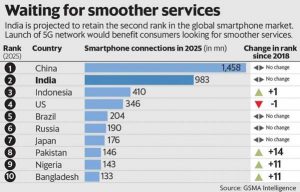
What is the global progress on 5G?
- More than governments, global telecom companies have started building 5G networks and rolling it out to their customers on a trial basis. In countries like the US, companies such as AT&T, T-mobile, and Verizon have taken the lead when it comes to rolling out commercial 5G for their users.
- In other countries such as China, some of the telcos such as China Unicom had started 5G trials as early as 2018, and have since rolled out the commercial services for users.

THE PRELIMS PRACTICE QUESTION
Q1. In the context of Colonial India, Shah Nawaz Khan, Prem Kumar Sehgal and Gurbaksh Singh Dhillon are remembered as:
a) leaders of Swadeshi and Boycott Movement
b) members of the Interim Government in 1946
c) members of the Drafting Committee in the Constituent Assembly
d) officers of the Indian National Army
ANSWER FOR 27TH DECEMBER 2021
ANSWER: D
EXPLANATION:
- Triclosan is a chemical with antibacterial properties. Generally, it is used in Toiletries. For decades, triclosan has been added to personal care products, such as hand soaps and cosmetics, and materials ranging from athletic clothing to food packaging. When you use a product containing triclosan, you can absorb a small amount through your skin or mouth.